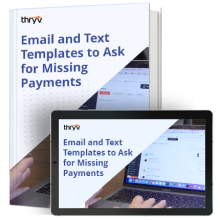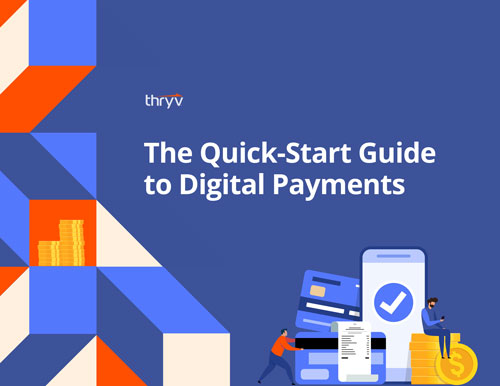Building a small business website comes with quite a few decisions. You may have asked yourself:
- What should my business website include?
- How many calls to action should my website have?
- How do I get this pesky Contact Us form to connect to my email?
Whether you knew it or not, you made hundreds of choices as you designed and built your site.
But there’s one question you likely thought about longer than others. And that’s “Should I include a pricing page?”

Free: Email and Text Templates to Ask for Missing Payments
Use these free email and text templates to cut down on missed and late payments from your customers.
Save NowPricing Page Optimization
There are plenty of opinions out there on what a pricing page should (or should not) include. And there are tons of tips on how to optimize your pricing page for conversions.
But I’m not talking about conversions.
Take a couple steps back, and consider how your pricing page impacts a prospect’s (and ultimately a customer’s) journey. Sure, a well-optimized pricing page has the opportunity to convert a new lead and encourage repeat business.
But a successful pricing page targets more than conversions. A successful pricing page can serve additional purposes too, like:
- Share specific features and benefits of what you’re selling
- Explain accepted methods of payment
- Communicate your policies on returns and warranties
- Inspire further research
- Build trust and confidence
All of the above are ways to move a lead down the funnel and turn them into a customer without requiring an instant action on their part.
That’s why it’s so important to optimize your pricing page to be a positive part of the customer experience, no matter where they are in their journey with you.
Let’s dive into 6 ways your pricing page can impact your prospects’ and customers’ online experiences.
Watch Now: Why Your Website Should or Shouldn’t Have a Pricing Page
1. Consider Your Pricing Page Visitor’s Intent
Most prospects who land on your website’s pricing page have a pretty clear intent. They’re there to find your pricing. Yet, many businesses don’t publish their prices online.
What gives?
There are valid reasons businesses choose not to publish pricing online:
- You price your services on a custom proposal basis.
- Cost of materials is too variable to give accurate quotes online.
- Your pricing model is just too complex to put on a page.
The point is, if someone’s looking to your site for pricing and can’t find it, what do you offer them instead?
If you can’t match their exact intent, try meeting them halfway. Explain why you don’t share pricing upfront, and make the process of getting pricing as easy as possible.
Incorporate language into your page and your call-to-action buttons that make the ease of accessing pricing clear.
- “Call now for your free quote!”
- “Lowest price, guaranteed.”
- “Get an estimate in 5 minutes or less!”
2. Account for Every Stage of the Buying Cycle
If you’re assuming every visitor to your small business’s pricing page is ready to purchase, well, you know what they say about assuming …
It’s just not the case. Consumers can end up on your pricing page at any stage of the funnel, including earlier ones.
So if you’re only optimizing for bottom-of-the-funnel consumers (ready to buy or book), you’re likely missing the opportunity to capture warm (but not-quite-ready-to-buy) leads.
Consumers visit pricing pages looking for any number of things related to your pricing, like:
- Exact services you offer
- An in-depth feature list or product catalog
- Packages and bundles you may offer
- Contract or subscription terms
- Loyalty program details
- Cancellation fees
- Return or refund policies
The more information you can communicate in addition to pricing, the more likely you are to capture consumers who are earlier in the buying cycle.
Answer more questions. Convert more leads. Win more customers.
3. Clear Is Good — Simple Is Better
The best pricing pages include ridiculously easy-to-understand price points. The worst pricing pages include clear price points, but they tack on confusing fees, add-ons and even penalties.
Or, they don’t make it obvious exactly what pricing includes. Or, they don’t communicate a clear time frame or payment timeline for pricing. (I could go on.)
If you’re going to share your prices online, try to share as close to the final “all-in” price as you can. Then be transparent about what all it includes!
If your pricing page visitor needs a calculator, you’re doing it wrong.
4. There’s Psychology Behind “Starting at …” Language
One reason many business owners are hesitant to publish pricing online is because their services include multiple line items or variations.
Trying to publish pricing for every possibility isn’t only hard, it’s overwhelming for the business owner and the consumer. What you’re left with is no public pricing at all. And a bad customer experience.
Instead, have you considered sharing a “starting at” price?
Revealing a bare minimum price point can help your consumers avoid option overload. And nicely enough, it can also indicate that you’re willing to work with multiple budgets and price points. Win, win.
5. Good Things Come in Threes
From auto makers to liquor distributors, almost every industry has toyed around with a Good-Better-Best (G-B-B) pricing model. Offering tiered pricing expands your marketability and moves consumers further down the funnel of consideration.
Suddenly the question they’re asking themselves isn’t: “Should I buy from this business at this price point?” It’s: “Which package/plan/tier works best for me?”
As an added bonus, G-B-B pricing tiers can also offer a competitive advantage. With flat pricing, consumers are left to compare you to pricing from competitors.
With tiered pricing, you have more opportunities to capture consumers at the price they feel most willing to pay before they look to competitors for comparison.
3 Master Strategies for Raising Your Prices
Here’s what you need to keep in mind.
Pro tip: Remember option overload? Avoid inching too closely to this fine line by showing no more than three price points.
Even if your pricing model extends past what you publish online, providing too many options risks forcing a potential lead or customer into mental gymnastics … and losing the sale.
Exiting Your Page Is Part of the Journey
Eventually, those who visit your pricing page will inevitably leave your pricing page. If they’re submitted a contact form, booked an appointment or converted in any way, cool. You’ve done your job.
But if they haven’t, then what? Are you taking the opportunity to shoot your last shot with them? Why not?
If they’re leaving because they’re not yet ready to convert, there’s little to no risk of optimizing your pricing page to make a last ditch effort to convert them.
In fact, website conversion rate experts say 10-15% of exiting traffic can be saved by an exit-intent conversion tractic, like a pop-up.
Some ideas to get the creative juices flowing:
- Capture leads: Offer text and email offers in exchange for a phone number or email address. Then nurture these new contacts.
- Give a freebie: Give them something for free in exchange for converting (like an estimate or an introductory service).
- Entice bookings: Share a new customer booking discount for their first visit or service.
Your Pricing Page: Long Story Short
If you thought your pricing page was the pinnacle or final decision point of a prospect’s journey with you, it’s simply not always the case. You’re too zoomed in.
Zoom out.
The examples above could apply to almost any page on your website. The more time you take to understand the different places consumers may be in their journey with your business, the easier it will be to optimize your pricing page, ultimately your online experience … and to convert.

The Quickstart Guide
to Digital Payments
All you need to know about small business payment processing.








